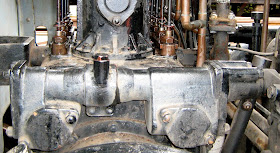 |
| Original Main Steam Pipe |
Unfortunately, this was not the end of the story. Being a main steam pipe wrapping around the boiler in the cab, it's very close to the driver. Hence it's not a nice thing to have fail at an inappropriate time!
Problems were found with the end fittings such that they could not be examined by X-ray to check the soundness of the welded end flanges. Complete new ends were machined from solid to avoid the necessity for any weld at the mating faces. The new section then had to be welded to the rest of the pipe to a high standard.
 |
| Brand-New Main Steam Pipe |
The original fittings have been salvaged for the new pipe.
 |
| End section and flange machined from solid |
 |
| One of the very tidy coded welds |
 |
| Bristol Harbour Railway's Peckett 0-6-0 'Henbury' tucked up in Midsomer Norton's Goods' Shed |
Wishing you Seasons' Greetings for Christmas and the new year. 7109 didn't quite steam in 2013 but I have high hopes for 2014.












































